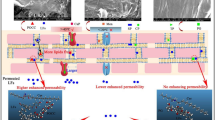Abstract
Purpose. To further increase the transdermal transport rate of R-apomorphine, a nonocclusive pretreatment with an aqueous surfactant formulation in combination with iontophoresis was explored in vitro.
Methods. The human stratum corneum was pretreated nonocclusively with formulations composed of laureth-3 oxyethylene ether (C12EO3), laureth-7 oxyethylene ether (C12EO7), and cholesterol sulfate (CSO4) prior to iontophoresis. The effect on the flux of the following parameters was examined: the composition, the charge, and the applied amount of surfactant formulations.
Results. The iontophoretic flux of R-apomorphine was appreciably increased by pretreatment with surfactant formulations. A formulation containing C12EO3/C12EO7/CSO4 at a molar ratio of 70:30:5 was very stable and increased the iontophoretic flux of R-apomorphine from 92.2 ± 13.9 nmol/cm2*h to 181.5 ± 22.6 nmol/cm2*h. When further increasing the negative charge of this formulation the iontophoretic transport rate was slightly inhibited. A dose of 40 μL/cm2 of the formulation with a total surfactant concentration of 5% (w/w) was sufficient for a maximum enhancing effect.
Conclusions. The results obviously show that nonocclusive pretreatment with the surfactant formulation enhances the iontophoretic transport of R-apomorphine, and is a promising approach to achieve therapeutic concentrations of R-apomorphine.
Similar content being viewed by others
REFERENCES
C. Colosimo, M. Merello, and A. Albanese. Clinical usefulness of apomorphine in movement disorders. Clin. Neuropharmacol. 17:243-259 (1994).
D. Muguet, E. Broussolle, and G. Chazot. Apomorphine in patients with Parkinson's disease. Biomed. Pharmacother. 49:197-209 (1995).
H. Sage. Iontophoresis. In E. W. Smith and H. I. Maibach (eds.), Percutaneous Penetration Enhancers, CRS Press, Boca Raton, Florida, 1995 pp. 351-368.
V. Nair, O. Pillai, R. Poduri, and R. Panchagnula. Transdermal iontophoresis. Part I: Basic principles and considerations. Methods Find. Exp. Clin. Pharmacol. 21:139-151 (1999).
R. van der Geest, M. Danhof, and H. E. Boddé. Iontophoretic delivery of apomorphine I: In vitro optimization and validation. Pharm. Res. 14:1798-1803 (1997).
R. van der Geest, T. van Laar, J. Gubbens-Stibbe, H. E. Boddé, and M. Danhof. Iontophoretic delivery of apomorphine II: An in vivo study in patients with Parkinson's disease. Pharm. Res. 14:1804-1810 (1997).
S. Mitragotri. Synergistic effect of enhancers for transdermal drug delivery. Pharm. Res. 17:1354-1359 (2000).
E. H. Choi, S. H. Lee, S. K. Ahn, and S. M. Hwang. The pretreatment effect of chemical skin penetration enhancers in transdermal drug delivery using iontophoresis. Skin Pharmacol. Appl. Skin Physiol. 12:326-335 (1999).
S. Chesnoy, D. Durand, J. Doucet, and G. Couarraze. Structural parameters involved in the permeation of propranolol HCl by iontophoresis and enhancers. J. Control. Release 58:163-175 (1999).
K. Hirvonen, Kontturi L., Murtomäki P, Paronen, and A. Urtti. Transdermal iontophoresis of sotalol and salicylate; the effect of skin charge and penetration enhancers. J. Control. Release 26:109-117 (1993).
G. L. Li, R. van der Geest, L. Chanet, E. van Zanten, M. Danhof, and J. A. Bouwstra. In vitro iontophoresis of R-apomorphine across human stratum corneum: The structure/transport relationship of penetration enhancement. J. Control. Release.
J. Baillie, A. T. Florence, L. R. Hume, G. T. Muirhead, and A. Rogerson. The preparation and properties of niosomes-nonionic surfactant vesicles. J. Pharm. Pharmacol. 37:863-868 (1985).
P. M. Frederik, P. H. H. Bomans, and M. C. A. Stuart. The ultrastructure of cryo-sections and intact vitrified cells the effect of cryoprotectanta and acceleration voltage on beam induced bubbling. Scanning Microsc. Suppl. 5:S43-S52 (1991).
J. Aungst. Structure/effect studies of fatty acid isomers as skin penetration enhancers and skin irritants. Pharm. Res. 6:244-247 (1989).
S. K. Gupta, S. Kumar, S. Bolton, C. R. Behl, and A. W. Malick. Effect of chemical enhancers and conducting gels on iontophoretic transdermal delivery of cromolyn sodium. J. Control. Release 31:229-236 (1994).
K. D. Peck, J. Hsu, S. K. Li, A. H. Ghanem, and W. I. Higuchi. Flux enhancement effects of ionic surfactants upon passive and elecroosmotic transdermal transport. J. Pharm. Sci. 87:1161-1169 (1998).
W. Hoss and C. Smiley. Binding and immobilization of catecholamines by liposomes. J. Neuroscience Res. 3:249-256 (1977).
V. Smith, R. B. Velagapudi, A. M. McLean, and R. E. Wilcox. Interactions of apomorphine with serum and tissue proteins. J. Med. Chem. Res. 28:613-620 (1985).
G. Cevc. Transfersomes, liposomes and other lipid suspensions on the skin: Permeation enhancement, vesicle penetration, and transdermal drug delivery [review]. Crit. Rev. Ther. Drug Carrier Syst. 13:257-388 (1996).
H. E. J. Hofland. Vesicles as transdermal drug delivery systems. Ph.D. Thesis, Leiden University, The Netherlands, 1992, pp. 93-132.
S. J. Jiang, S. M. Hwang, E. H. Choi, P. M. Elias, S. K. Ahn, and S. H. Lee. Structural and functional effects of oleic acid and iontophoresis on hairless mouse stratum corneum. J. Invest. Dermatol. 114:64-70 (2000).
K. S. Bhatia and J. Singh. Effect of linolenic acid/ ethanol or limonene/ethanol and iontophoresis on the in vitro percutaneous absorption of LHH and ultrastructure of human epidermis. Int. J. Pharm. 180:235-250 (1999).
K. S. Bhatia, S. Gao, T. P. Freeman, and J. Singh. Effect of penetration enhancers and iontophoresis on the ultrastructure and cholecystokinin-8 permeability though porcine skin. J. Pharm. Sci. 86:1011-1015 (1997).
N. Kalia and R. H. Guy. Interaction between penetration enhancers and iontophoresis: Effect on human skin impedance in vivo. J. Control. Release 44:33-42 (1997).
H. E. J. Hofland, J. A. Bouwstra, J. C. Verhoef, G. Buckton, B. Z. Chowdry, M. Ponec, and H. E. Junginger. Safety aspects of non-ionic surfactant vesicles: a toxicity study related to the physicochemical characteristics of non-ionic surfactants. J. Pharm. Pharmacol. 44:287-294 (1992).
Author information
Authors and Affiliations
Corresponding author
Rights and permissions
About this article
Cite this article
Li, G.L., Danhof, M., Frederik, P.M. et al. Pretreatment with a Water-Based Surfactant Formulation Affects Transdermal Iontophoretic Delivery of R-Apomorphine in Vitro . Pharm Res 20, 653–659 (2003). https://doi.org/10.1023/A:1023211219118
Issue Date:
DOI: https://doi.org/10.1023/A:1023211219118



